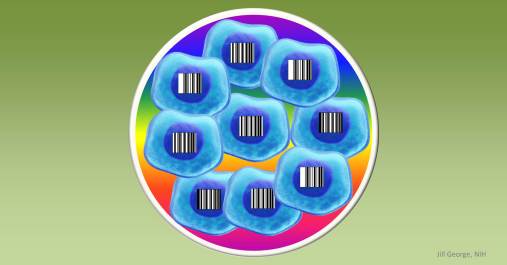DNA Barcodes Could Streamline Search for New Drugs to Combat Cancer
 A little more than a decade ago, researchers began adapting a familiar commercial concept to genomics: the barcode. Instead of the black, printed stripes of the Universal Product Codes (UPCs) that we see on everything from package deliveries to clothing tags, they used short, unique snippets of DNA to label cells. These biological “barcodes” enable scientists to distinguish one cell type from another, in much the same way that a supermarket scanner recognizes different brands of cereal.
A little more than a decade ago, researchers began adapting a familiar commercial concept to genomics: the barcode. Instead of the black, printed stripes of the Universal Product Codes (UPCs) that we see on everything from package deliveries to clothing tags, they used short, unique snippets of DNA to label cells. These biological “barcodes” enable scientists to distinguish one cell type from another, in much the same way that a supermarket scanner recognizes different brands of cereal.DNA barcoding has already empowered single-cell analysis, including for nerve cells in the brain. Now, in a new NIH-supported study, DNA barcoding helps in the development of a new method that could greatly streamline an increasingly complex and labor-intensive process: screening for drugs to combat cancer.
The new method, reported recently in the journal Nature Biotechnology, is called PRISM, short for Profiling Relative Inhibition Simultaneously in Mixtures [1]. In their trial run of PRISM, the researchers uniquely barcoded more than 100 cancer cell lines. This allowed them to pool the cell lines and screen them all at the same time (instead of individually) against each of thousands of potential drug compounds, to see which, if any, of the barcoded cells they had the power to kill. This proof of concept suggests that PRISM, with further refinements, could help to accelerate cancer drug discovery and bring greater precision to the screening process.
This innovative research was led by the lab of Todd Golub of the Broad Institute of MIT and Harvard, Cambridge, MA. PRISM consists of two key components. The first is a library of uniquely barcoded cancer cell lines. Golub and colleagues produced the library by using a virus to insert a distinct DNA barcode, just 24 nucleotides long, stably into the genomes of each genetically distinct tumor cell line.
The second component is a barcode detection system. It scans tiny, color-coded beads that are preprogrammed to bind to a specific barcode, providing a tally of each cell line present in a mixture. A special stain allows researchers to quantify the barcodes attached to each colored bead based on the intensity of their fluorescence.
In the study, the researchers first pooled five barcoded cancer cell lines to see if the PRISM method worked as intended. They found that the detection system had outstanding sensitivity, detecting as few as 10 uniquely barcoded cells in a pool of 4,000! In the next key test, the researchers exposed a mixture of 25 barcoded lung cancer cell lines to approved cancer drugs. For each drug, sensitive cells were killed, and so those barcodes dropped out—but the resistant cells and their barcodes were retained. They found that the drug responses from the barcoded cells largely mirrored those reported previously for the 25 cell lines.
Now that PRISM had passed these initial tests, the researchers moved on to screen 102 cancer cell lines across 8,400 compounds—most with unknown effects on cancer. Those screens revealed 90 chemicals that selectively killed some cancer cell lines and not others. Golub and his team focused in detail on one of those chemicals called BRD-7880. By comparing the effects of this novel compound to those of others in the screen, the researchers figured out how BRD-7880 works and which types of cancer cells it is likely to kill. This shows how PRISM could be employed to discover novel drug candidates with remarkable ease and also elucidate quickly their mechanisms of action.
With PRISM, it’s now feasible to screen entire small molecule libraries across large panels of cancer cell lines. The approach might also be put to use for optimizing drug candidates or for discovering new uses for cancer drugs that have already been FDA approved. The researchers say they have now produced about 700 barcoded cancer cell lines, and this collection can be expanded to represent thousands of genetically distinct human cancers.
The more scientists have learned about the diversity of mutations that drive various forms of cancer, the clearer it has become that successfully combating these diseases will require a diverse arsenal of targeted approaches to therapy. While that remains a tremendous challenge, this new method could help to bring the goal of discovering many more precise and effective cancer treatments within better reach.
Reference:
[1] High-throughput identification of genotype-specific cancer vulnerabilities in mixtures of barcoded tumor cell lines. Yu C, Mannan AM, Yvone GM, Ross KN, Zhang YL, Marton MA, Taylor BR, Crenshaw A, Gould JZ, Tamayo P, Weir BA, Tsherniak A, Wong B, Garraway LA, Shamji AF, Palmer MA, Foley MA, Winckler W, Schreiber SL, Kung AL, Golub TR. Nat Biotechnol. 2016 Feb 29. [Epub ahead of print]
Links:
Todd Golub (Broad Institute, Cambridge, MA)
Genome Based Drug Discovery (Common Fund/NIH)
NCI and Precision Medicine Initiative (National Cancer Institute/NIH)
NIH Support: National Cancer Institute; National Human Genome Research Institute; National Institute of General Medical Sciences; National Institute of Dental and Craniofacial Research


































No hay comentarios:
Publicar un comentario